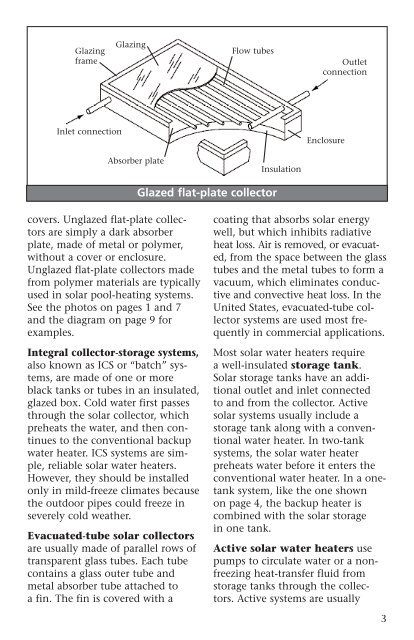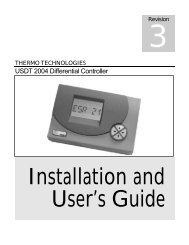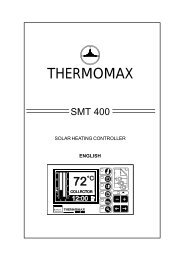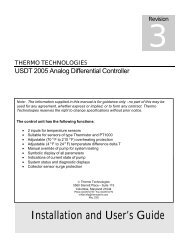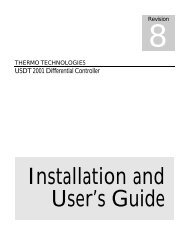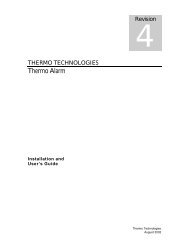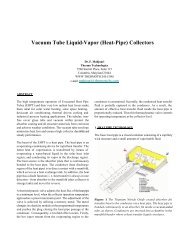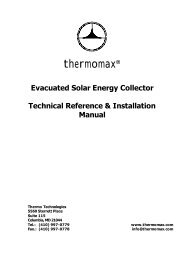Heat Your water with the Sun - Thermomax Technologies
Heat Your water with the Sun - Thermomax Technologies
Heat Your water with the Sun - Thermomax Technologies
You also want an ePaper? Increase the reach of your titles
YUMPU automatically turns print PDFs into web optimized ePapers that Google loves.
Glazing<br />
frame<br />
Glazing<br />
Flow tubes<br />
Outlet<br />
connection<br />
Inlet connection<br />
Enclosure<br />
Absorber plate<br />
Insulation<br />
Glazed flat-plate collector<br />
covers. Unglazed flat-plate collectors<br />
are simply a dark absorber<br />
plate, made of metal or polymer,<br />
<strong>with</strong>out a cover or enclosure.<br />
Unglazed flat-plate collectors made<br />
from polymer materials are typically<br />
used in solar pool-heating systems.<br />
See <strong>the</strong> photos on pages 1 and 7<br />
and <strong>the</strong> diagram on page 9 for<br />
examples.<br />
Integral collector-storage systems,<br />
also known as ICS or “batch” systems,<br />
are made of one or more<br />
black tanks or tubes in an insulated,<br />
glazed box. Cold <strong>water</strong> first passes<br />
through <strong>the</strong> solar collector, which<br />
preheats <strong>the</strong> <strong>water</strong>, and <strong>the</strong>n continues<br />
to <strong>the</strong> conventional backup<br />
<strong>water</strong> heater. ICS systems are simple,<br />
reliable solar <strong>water</strong> heaters.<br />
However, <strong>the</strong>y should be installed<br />
only in mild-freeze climates because<br />
<strong>the</strong> outdoor pipes could freeze in<br />
severely cold wea<strong>the</strong>r.<br />
Evacuated-tube solar collectors<br />
are usually made of parallel rows of<br />
transparent glass tubes. Each tube<br />
contains a glass outer tube and<br />
metal absorber tube attached to<br />
a fin. The fin is covered <strong>with</strong> a<br />
coating that absorbs solar energy<br />
well, but which inhibits radiative<br />
heat loss. Air is removed, or evacuated,<br />
from <strong>the</strong> space between <strong>the</strong> glass<br />
tubes and <strong>the</strong> metal tubes to form a<br />
vacuum, which eliminates conductive<br />
and convective heat loss. In <strong>the</strong><br />
United States, evacuated-tube collector<br />
systems are used most frequently<br />
in commercial applications.<br />
Most solar <strong>water</strong> heaters require<br />
a well-insulated storage tank.<br />
Solar storage tanks have an additional<br />
outlet and inlet connected<br />
to and from <strong>the</strong> collector. Active<br />
solar systems usually include a<br />
storage tank along <strong>with</strong> a conventional<br />
<strong>water</strong> heater. In two-tank<br />
systems, <strong>the</strong> solar <strong>water</strong> heater<br />
preheats <strong>water</strong> before it enters <strong>the</strong><br />
conventional <strong>water</strong> heater. In a onetank<br />
system, like <strong>the</strong> one shown<br />
on page 4, <strong>the</strong> backup heater is<br />
combined <strong>with</strong> <strong>the</strong> solar storage<br />
in one tank.<br />
Active solar <strong>water</strong> heaters use<br />
pumps to circulate <strong>water</strong> or a nonfreezing<br />
heat-transfer fluid from<br />
storage tanks through <strong>the</strong> collectors.<br />
Active systems are usually<br />
3


